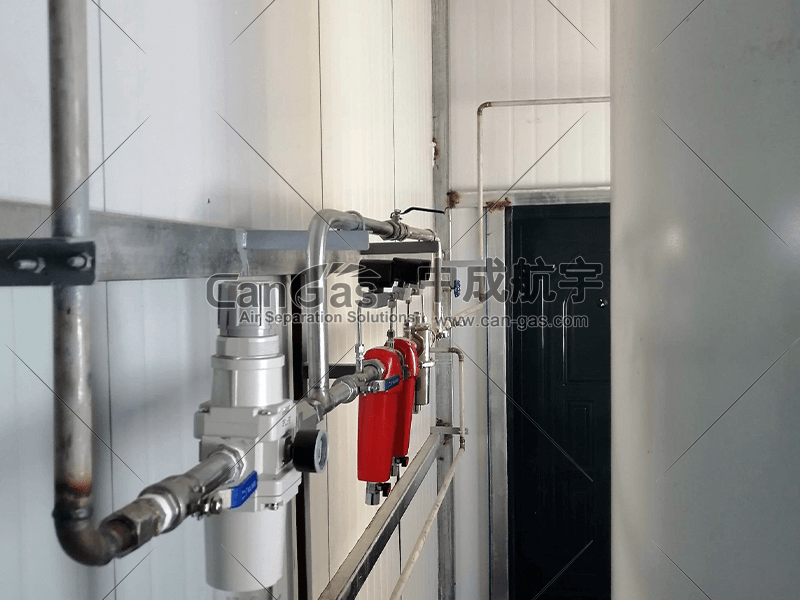General specification of pipeline for medical central oxygen supply system
ReturnMedical central oxygen supply system is composed of central oxygen supply station, pipeline, valve and oxygen supply plug terminal. The product oxygen is produced by the central oxygen supply station, and then transported to the operating room, rescue room, treatment room and the terminal of each ward through the pipeline and pressure relief device for medical usage.
In China's pharmaceutical industry standards, there are clear technical regulations for the medical system. For the central oxygen supply system pipeline, the following technical conditions should be met to satisfy the relevant national requirements.
1. Piping system materials
1.1 The oxygen pipeline system is made of stainless steel pipe, deoxidized copper pipe or pure copper pipe. Stainless steel pipes shall meet the requirements in standard GB/T14976, and deoxidized copper pipes and pure copper pipes shall meet the requirements in standard GB 1527. The pipes shall be free from mechanical damage and visible serious corrosion.
1.2 Materials of oxygen valves and other accessories: when the working pressure is higher than 3 MPa, copper or stainless steel shall be used as the base, and metal sealing materials shall be used; When the working pressure is less than 3 MPa, other metal materials compatible with oxygen can be used as the matrix and other nonflammable non-metallic materials compatible with oxygen can be used as the sealing materials.
2. Pipe diameter
2.1 The diameter of the oxygen pipe shall ensure that the pressure at the end of the anesthesia machine, respirator and other medical devices is not less than 0.4 MPa; The pressure at the terminal of the general ward shall not be less than 0.2 MPa.
2.2 When choose the diameter of the pipe,the pressure loss of it, even at the farthest pipe, shall not exceed 10%.
3. Pipe laying
3.1 The oxygen pipeline is not allowed to be laid in the same frame with the fuel gas and fuel pipes. If it must be laid in the same frame, it shall be kept distance more than 0.5meter with the pipe; and there shall be no valve and connection joint in the common frame.
3.2 Oxygen pipes are nerther not allowed to be laid on the same frame with conductive lines and cables, nor to cross contact with conductive lines and cables, so as to prevent accidents caused by leakage sparks penetrating the pipes.
3.3 When the oxygen pipeline passes through the wall or floor, it shall be laid in the casing, and the pipe section in the casing shall not have welds and connection joints.
3.4 Oxygen pipeline is not allowed to be buried in the building structure or laid in the tube well without inspection door (or inspection port), and it is not allowed to be laid in the same tube well with the power supply line.
3.5 Set supports at proper positions of the pipeline. See the following table for support spacing
Diameter/mm | >1〜4 | >4〜8 | >8-12 | >12 〜20 | >20 〜25 | >25 |
Maximum support spacing/m | 1.0 | 1.5 | 2.0 | 2.5 | 3.0 | 4.0 |
4. The oxygen pipeline must be reliably grounded, with the grounding resistance less than 100 Ω.
5. A safety valve shall be set behind the pressure reducer. The opening pressure of the safety valve is 1.1-1.25 times the maximum working pressure of the pipeline system, and the pipeline pressure shall not be greater than 1.25 times the maximum working pressure of the pipeline system; The reseating pressure of the safety valve shall be less than the maximum working pressure of the pipeline system.
6. All pipes, pipe fittings, instruments, valves and all other accessories contacting with oxygen gas must be degreased in advance. After degreasing, the pipes shall be blown with oil-free air.
7. The test pressure of the pressure test of the pipeline system is 1.25 times of the maximum working pressure of the pipeline system. Joints, welds and pipes shall be free of leakage and visible deformation.
8. The test pressure for the air tightness test of the pipeline system is the maximum working pressure of the pipeline system. Discharge rate in one hour shall be less than 0.5%.


